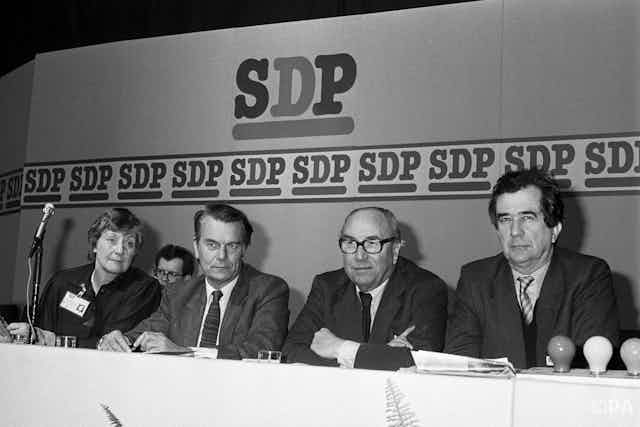We’ve been here before, or so it seems. A left-wing Labour leader the parliamentary party feels was foisted upon it, ongoing ideological warfare, and a fear of impending electoral Armageddon. The last time this happened was in 1981 when such circumstances led to the creation of the Social Democratic Party, the first new major mainstream political party in almost a century. Could Jeremy Corbyn’s leadership of the Labour Party, the demolition of the Liberal Democrats in parliament, and even strife among the Conservatives trigger similar events today and the creation of a new party to capture the centre ground?
In some ways, the current state of Labour seems ideal to foster a breakaway. Corbyn might actually be to the left of Michael Foot, the Labour leader at the time of the creation of the SDP. While Foot was a member of the Tribune Group of MPs, Corbyn comes from the Socialist Campaign Group, a group historically associated with the more radical Bennite left. Foot was also an experienced cabinet minister who enjoyed far more support and respect from colleagues than Corbyn does today.

A modern version of the SDP might have some support to draw upon. Media reports claim that nearly 14,000 Labour members have left the party since Corbyn became leader. While this is dwarfed by the nearly 200,000 new members who have joined since May 2015, it suggests that there are dissatisfied natural Labour supporters who could make up the nucleus of a new party.
Perhaps a new party might be able to attract some of Labour’s major donors to provide the financial resources for the project – this would be particularly important as it seems unlikely that the new party would be able to draw on any significant support from the trades unions.
Changed days
If there are some arguments in support of the possibility of a SDP-style breakaway, however, there are many more arguments as to why it’s unlikely. The destruction of the Liberal Democrats in 2015 poses both a tactical and strategic dilemma for any would-be secessionists. Tactically, it means there is no longer a large group of centrist MPs who might be open to being folded into an electoral pact – as the former Liberal Party agreed to with the SDP, running as the Alliance. But more strategically, it raises serious questions about just how deep the well of potential support really is for a centrist third party in British politics.

A breakaway party would also have problems in terms of leadership. The Labour politicians who founded the SDP – the “Gang of Four” – were “big beasts”: Roy Jenkins had formerly been deputy party leader, chancellor of the exchequer, home secretary and president of the European Commission. David Owen had been foreign secretary, Shirley Williams a former secretary of state for education and science, and Bill Rodgers a former secretary of state for transport.
But due to various historical accidents, lost parliamentary seats and early retirements, the current parliamentary Labour Party lacks figures of this statute – with the possible exception of Harriet Harman, a former deputy party leader, and Alan Johnson, who has held previous roles as home secretary and security of state for health and education to his name.
The weight of history
But, ultimately, the reason why history may not repeat itself is history itself. The SDP turned out to be an electoral dead end, largely due to Britain’s first past the post electoral system that works against new parties. In the 1983 general election the SDP received 25.4% of the vote, just behind Labour with 27.6%, but won only 23 seats in the Commons compared to Labour’s 209 seats. Unless a new breakaway party could find a way to significantly deplete Labour’s core vote, it would likely suffer the same fate. Indeed, it is a supreme irony that many of the SDP’s ideas only really became influential when championed by New Labour modernisers.
One of the central insights of the New Labour project is the importance of winning office – something repeated ad nauseam in criticism of Corbyn. So adherents to the New Labour creed are highly unlikely to choose any option that looks like a one-way ticket into the political wilderness.
What, then, is a centrist MP to do? The starting point must be an assessment of where they have gone wrong. It is very easy to blame the three leadership candidates Corbyn defeated, but this misses the point. Far more important was the intellectual exhaustion at the heart of the New Labour project. New Labour’s successes all took place during periods of economic growth and confidence, which allowed increased spending on public services without greatly increasing the tax burden. In these more financially straitened times this isn’t an option.
Which poses the broader question – whether asked from within the Labour Party or outside it – of what centre-left politics is for, what is its vision of the good society? Without an answer to that, any centre-left political project will remain fatally flawed.

